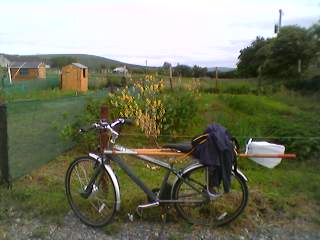

|
About Us |
| News |
| Newsletters and Factsheets |
| Links |
| Contact |
| Photographs | Home |

 Do you cycle to yours? |
|
Notice to Plot Holders - Vigilance needed Who are we? South Dublin Allotments Association (SDAA) is a not for profit association made up mostly of allotment holders who garden on South Dublin County Council’s four allotments sites at Friarstown (outside Tallaght), Corkagh Park, Tymon Park and Palmerstown. What do we do? We represent the interests of SDCC allotment holders, we promote good practice, we educate the public all about allotments, and we campaign for more allotments to be made available to local communities. We are not involved in the allocation of plots by the Council. The work of the association is led by a committee who are elected by the wider membership of the association. We organise open days for the public and information days for new allotment holders. We operate a discounted seed scheme for members, and publish a newsletter three times a year. SDAA welcomes new members: current allotment holders, those on the waiting list for a plot, and those interested in supporting the allotments movement in Ireland. See our membership section for details on joining. Individual membership costs only €10.00 annually!!! What Are Allotments? Allotments, are plots of land under the control of local authorities which are rented out, at a modest cost, for the purpose of growing food for private domestic use. There can be several, dozens or even hundreds of plots on a single allotments site. Allotments-type systems exist in many countries, and Irish people travelling abroad have often have noticed countless allotments in cities and towns across Britain, France and Germany. In some countries what we call "allotments" are also leisure gardens - they have chalets and are used as weekend retreats. Here in Ireland we have had allotments in operation for at least 100 years. Many Irish families will remember when produce grown in allotments and back gardens was essential in sustaining families. Legislation covering allotments here dates back to the 1926 Acquisition of Land (Allotments) Act. This allows for local authorities to acquire land and set up allotments schemes in response to demand. More recent legislation such as the Local Government Act 2001 also provides for local authorities to set up allotments based on the demand for them. This demand has ebbed and flowed over the years but was at its peak during the war years (World War I and II). Since the 1950s there has been a decline in allotments provision and many sites closed down, until about 5 years ago when a reversal began to happen in this trend. Now we see a huge upsurge in interest in allotments in Ireland and across the globe. Wherever they exist, there are escalating waiting lists as local authorities struggle to keep pace with the demand. It is likely that this interest is coming from many factors. People are becoming discerning and more empowered concerning food. Some people are interested in providing quality organic food rather than highly processed produce for their families. More is being learned all the time about the positive health benefits (including medicinal) of vegetables, fruit and herbs. There are concerns about climate change and the environmental costs inherent in oil based, mass produced food systems. Many people seek a connection with nature and look to allotment growing to reduce stress and get back to a way of life they or their parents and grandparents may have grown up with. Also, and very significantly, many friendships are made on allotments. It is likely that these and other factors have all played their part. However to seasoned allotment holders, what they enjoy about their plot is often indefinable or indescribable. It feels "natural" or habitual to them - they just do it because it’s what they do, and they clearly find it intrinsically satisfying and fulfilling! For more about allotments click on our Qs and A’s on allotments Our Association, SDAA, as well as representing allotment holders on South Dublin County Council sites and encouraging good practice in allotment keeping, campaigns for more allotments sites both locally and nationally. We see the allotments system as more relevant than ever, as a sustainable food system par excellence for the new era we are swiftly entering. We network with and support other groups, as part of the emerging allotments movement in Ireland, and are pressing for a national strategy for the development of allotments and community gardens, so that they are available in or near centres of population across the whole country. Allotments Availability in Dublin: South Dublin County Council Fingal County Council Dun Laoghaire-Rathdown County Council Dublin City Council Q’s and A’s about Allotments Who is entitled to apply for an allotment? Anyone who is capable of managing a plot is entitled to apply for an allotment. Generally, local authorities confine applications to residents of their own catchment area. How much does it cost to rent an allotment? Local authorities typically charge between €40-€100 per plot, depending on size of the plot. How big is an allotment plot? The standard plot in England and Wales is the "10 pole plot" which measures equates to 300 sq yds or 250 sq metres or one sixteenth of an acre.This plot size, properly husbanded, can feed a family of four for a year. This means that one acre of land should give 12-15 as an optimum number of plots per acre, allowing for haulage ways. Traditionally plots in Ireland were 1/10th acre, but the tendency in recent years has been towards smaller plots of 80-120 sqm. (This could be described as the size of a small to medium sized Irish urban or suburban back garden) Some local authorities have some bigger plots of 250 sqm , and at the opposite end of the scale, some "starter plots" of 50 sqm. How many plots are on each site? There can be anything from a few plots, up to hundreds of plots on one allotment site. The bigger sites in the UK and the continent have many hundreds of plots. Are there any on site facilities? Almost all sites provide running water, parking, and perimeter fencing. These, along with the land itself are the basic infrastructure of an allotment site and are usually the responsibility of the local authority. Storage facilities for tools and toilet facilities are provided on many sites. How does the allotments system work? The basis of the system is a detailed contract, renewed yearly in mid winter, between the County Council and the allotment holder. The allotment holder, in order to retain the plot has to show that he/she is making use of the plot for the purpose for which it was intended. The Council inspects the plots regularly and takes back plots which are being unused or neglected. The allotment holder also has responsibilities to other allotment holders and to the site itself which are detailed in the contract. Unlike in community gardens each plot is the sole responsibility of the allotment holder who has signed the contract for that plot. What am I allowed to grow? The primary purpose of an allotment is to grow any vegetables, fruit (usually only soft fruit is allowed) and herbs that you may need for your own private domestic use. Fruit tree growing is restricted, or not allowed, as trees may eventually cause shade on neighbouring plots and are seen as "permanent" plantings. Some flowers are also grown by allotment holders to improve the look of the plot and the allotment site, as well as having some cut flowers for the home. Flowers also encourage biodiversity on allotment sites.What kind of time commitment is involved? Obviously, to grow crops successfully and maintain a plot well a considerable time commitment is involved. Starting out with a plot there is often a big time commitment involved in getting the plot ready for cultivation. Generally, at least 3 hours a week is involved during busy periods in the main growing season (March-September). Many skilled growers spend a lot more time than this-and reap the rewards at harvest time. Frequent trips to the plot are important in identifying problems such as slug or bird damage at an early stage. Some approaches to gardening save a lot of time-for example "no dig" methods, or mulching around plants, which cuts back on watering the plot during the summer months. It is possible to ask a friend to help with watering, weeding etc if you are away on holidays for a few weeks.If the time commitment is too much our association encourages people to hand back their plot as soon as possible, so that someone who has been on the waiting list for a long time gets her/his opportunity at growing her/his own vegetables. This website is a work in progress. Suggestions and ideas for content are welcome. Keep logging on for updates. |